基于确保疲劳强度和减轻重量的转向架构架设计-外文资料翻译
- 格式:doc
- 大小:2.08 MB
- 文档页数:22
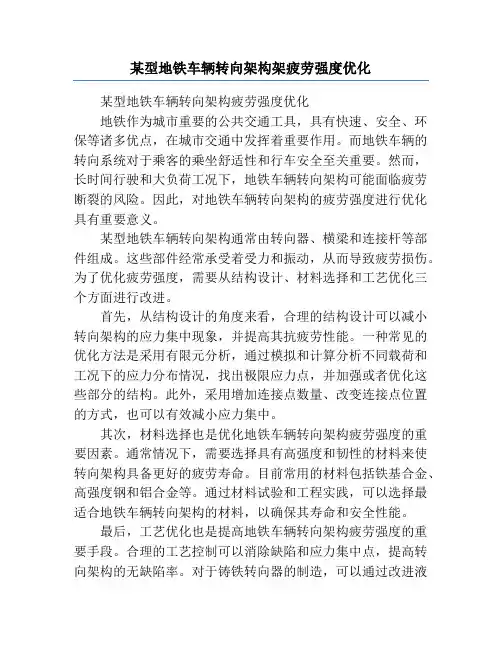
某型地铁车辆转向架构架疲劳强度优化某型地铁车辆转向架构疲劳强度优化地铁作为城市重要的公共交通工具,具有快速、安全、环保等诸多优点,在城市交通中发挥着重要作用。
而地铁车辆的转向系统对于乘客的乘坐舒适性和行车安全至关重要。
然而,长时间行驶和大负荷工况下,地铁车辆转向架构可能面临疲劳断裂的风险。
因此,对地铁车辆转向架构的疲劳强度进行优化具有重要意义。
某型地铁车辆转向架构通常由转向器、横梁和连接杆等部件组成。
这些部件经常承受着受力和振动,从而导致疲劳损伤。
为了优化疲劳强度,需要从结构设计、材料选择和工艺优化三个方面进行改进。
首先,从结构设计的角度来看,合理的结构设计可以减小转向架构的应力集中现象,并提高其抗疲劳性能。
一种常见的优化方法是采用有限元分析,通过模拟和计算分析不同载荷和工况下的应力分布情况,找出极限应力点,并加强或者优化这些部分的结构。
此外,采用增加连接点数量、改变连接点位置的方式,也可以有效减小应力集中。
其次,材料选择也是优化地铁车辆转向架构疲劳强度的重要因素。
通常情况下,需要选择具有高强度和韧性的材料来使转向架构具备更好的疲劳寿命。
目前常用的材料包括铁基合金、高强度钢和铝合金等。
通过材料试验和工程实践,可以选择最适合地铁车辆转向架构的材料,以确保其寿命和安全性能。
最后,工艺优化也是提高地铁车辆转向架构疲劳强度的重要手段。
合理的工艺控制可以消除缺陷和应力集中点,提高转向架构的无缺陷率。
对于铸铁转向器的制造,可以通过改进液态金属充模工艺,控制金属的凝固过程,减少凝固缩孔和夹杂物的发生。
此外,优化焊接工艺、热处理过程和表面处理方法,也可以提高地铁车辆转向架构的疲劳寿命。
综上所述,某型地铁车辆转向架构疲劳强度的优化是确保地铁运行安全的关键要素之一。
通过结构设计的改进、材料选择的优化和工艺的改进,可以提高地铁车辆转向架构的疲劳强度,延长其使用寿命,确保地铁运行的安全性和可靠性。
同时,在实际的工程应用过程中,还需要考虑成本、制造难度和可行性等因素,综合各方面因素进行综合权衡,寻求最佳的解决方案综合考虑地铁车辆转向架构的结构设计、材料选择和工艺优化等方面,可以有效提高其疲劳强度并延长使用寿命,从而确保地铁运行的安全性和可靠性。

•引言•实测载荷数据处理•转向架构架疲劳试验载荷谱建立目•疲劳试验载荷谱分析•结论与展望录研究目的和意义回顾现有研究在实测载荷下进行转向架构架疲劳试验方面的研究现状。
提出当前研究中存在的问题和不足。
介绍转向架构架在轨道交通领域的应用和重要性。
详细描述本研究的研究方法和实施流程。
介绍数据采集和处理方法,包括载荷数据的采集和处理、信号处理等。
阐述基于实测载荷的转向架构架疲劳试验的实现方法和具体操作流程。
采集位置在列车运行过程中,每隔一段时间或按照特定的行驶模式进行数据采集。
采集时间数据存储实测载荷数据采集数据清洗数据转换数据归纳030201实测载荷数据处理方法趋势分析疲劳试验载荷谱制定特征提取数据处理结果03利用有限元分析方法01基于实测载荷数据02理论计算与实测数据结合建立方法数据采集和处理载荷时间历程载荷统计和处理建立载荷谱建立过程确定载荷边界条件验证试验有效性载荷谱结果平均应力交变应力最大应力载荷谱特征分析局部应力集中找出应力集中的部位,这些部位可能存在应力腐蚀或疲劳裂纹萌生的风险。
高应力区域识别承受高应力的关键部位,这些区域可能对构架的疲劳寿命产生较大影响。
关键连接部位分析连接部位的受力情况,确保这些部位在运行过程中保持稳定和可靠。
关键部位识别基于实测载荷的预测利用实测载荷数据,通过疲劳寿命预测模型估算构架的疲劳寿命。
基于应力-寿命曲线利用已知的应力-寿命曲线,根据分析得到的应力水平评估构架的疲劳寿命。
考虑多种影响因素考虑其他影响因素如材料性能、制造工艺、运行环境等对构架疲劳寿命的影响。
疲劳寿命预测数据分析疲劳试验设计实测载荷数据的获取研究结论研究不足与展望数据处理方法01试验条件02载荷谱适用性031 2 3转向架构架的疲劳寿命预测车辆运行安全性评估新型转向架构架研发工程应用前景。
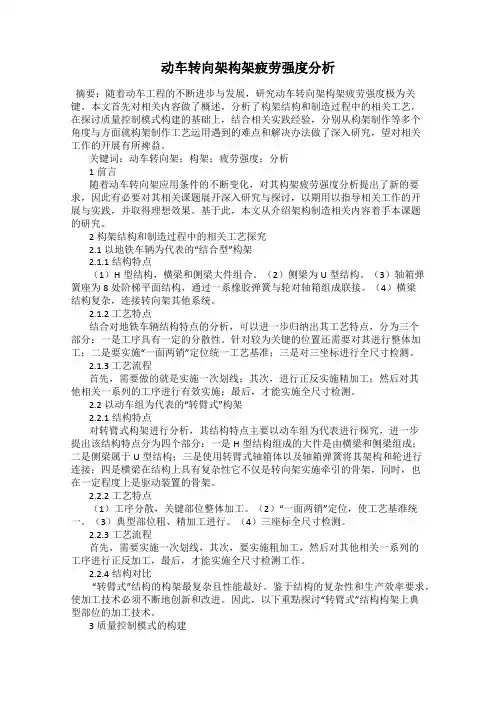
动车转向架构架疲劳强度分析摘要:随着动车工程的不断进步与发展,研究动车转向架构架疲劳强度极为关键。
本文首先对相关内容做了概述,分析了构架结构和制造过程中的相关工艺,在探讨质量控制模式构建的基础上,结合相关实践经验,分别从构架制作等多个角度与方面就构架制作工艺运用遇到的难点和解决办法做了深入研究,望对相关工作的开展有所裨益。
关键词:动车转向架;构架;疲劳强度;分析1前言随着动车转向架应用条件的不断变化,对其构架疲劳强度分析提出了新的要求,因此有必要对其相关课题展开深入研究与探讨,以期用以指导相关工作的开展与实践,并取得理想效果。
基于此,本文从介绍架构制造相关内容着手本课题的研究。
2构架结构和制造过程中的相关工艺探究2.1以地铁车辆为代表的“结合型”构架2.1.1结构特点(1)H型结构,横梁和侧梁大件组合。
(2)侧梁为U型结构。
(3)轴箱弹簧座为8处阶梯平面结构,通过一系橡胶弹簧与轮对轴箱组成联接。
(4)横梁结构复杂,连接转向架其他系统。
2.1.2工艺特点结合对地铁车辆结构特点的分析,可以进一步归纳出其工艺特点,分为三个部分:一是工序具有一定的分散性。
针对较为关键的位置还需要对其进行整体加工;二是要实施“一面两销”定位统一工艺基准;三是对三坐标进行全尺寸检测。
2.1.3工艺流程首先,需要做的就是实施一次划线;其次,进行正反实施精加工;然后对其他相关一系列的工序进行有效实施;最后,才能实施全尺寸检测。
2.2以动车组为代表的“转臂式”构架2.2.1结构特点对转臂式构架进行分析,其结构特点主要以动车组为代表进行探究,进一步提出该结构特点分为四个部分:一是H型结构组成的大件是由横梁和侧梁组成;二是侧梁属于U型结构;三是使用转臂式轴箱体以及轴箱弹簧将其架构和轮进行连接;四是横梁在结构上具有复杂性它不仅是转向架实施牵引的骨架,同时,也在一定程度上是驱动装置的骨架。
2.2.2工艺特点(1)工序分散,关键部位整体加工。
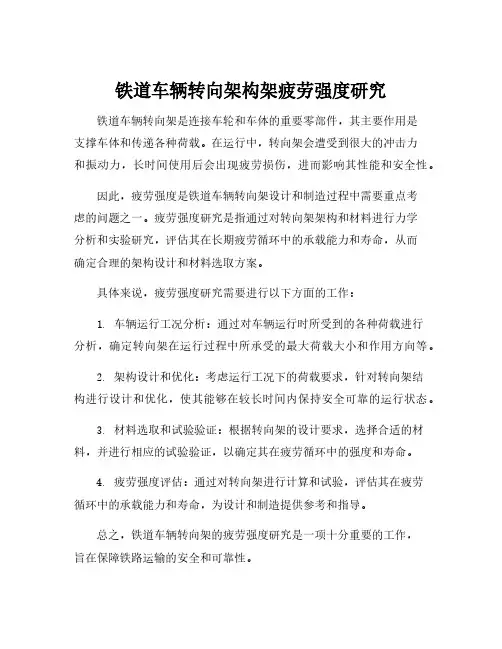
铁道车辆转向架构架疲劳强度研究铁道车辆转向架是连接车轮和车体的重要零部件,其主要作用是
支撑车体和传递各种荷载。
在运行中,转向架会遭受到很大的冲击力
和振动力,长时间使用后会出现疲劳损伤,进而影响其性能和安全性。
因此,疲劳强度是铁道车辆转向架设计和制造过程中需要重点考
虑的问题之一。
疲劳强度研究是指通过对转向架架构和材料进行力学
分析和实验研究,评估其在长期疲劳循环中的承载能力和寿命,从而
确定合理的架构设计和材料选取方案。
具体来说,疲劳强度研究需要进行以下方面的工作:
1. 车辆运行工况分析:通过对车辆运行时所受到的各种荷载进行
分析,确定转向架在运行过程中所承受的最大荷载大小和作用方向等。
2. 架构设计和优化:考虑运行工况下的荷载要求,针对转向架结
构进行设计和优化,使其能够在较长时间内保持安全可靠的运行状态。
3. 材料选取和试验验证:根据转向架的设计要求,选择合适的材料,并进行相应的试验验证,以确定其在疲劳循环中的强度和寿命。
4. 疲劳强度评估:通过对转向架进行计算和试验,评估其在疲劳
循环中的承载能力和寿命,为设计和制造提供参考和指导。
总之,铁道车辆转向架的疲劳强度研究是一项十分重要的工作,
旨在保障铁路运输的安全和可靠性。
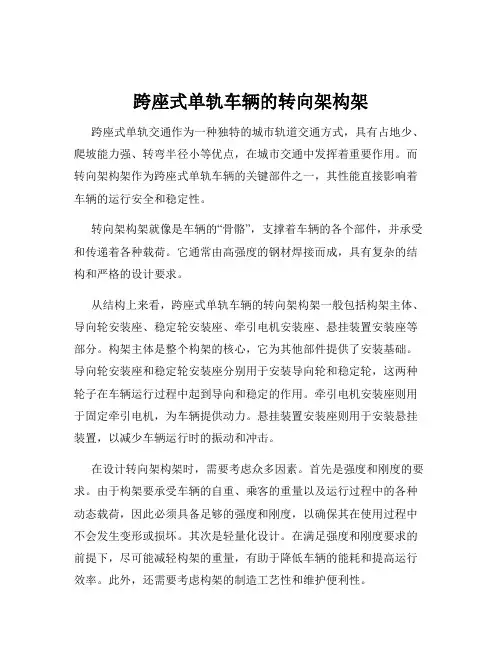
跨座式单轨车辆的转向架构架跨座式单轨交通作为一种独特的城市轨道交通方式,具有占地少、爬坡能力强、转弯半径小等优点,在城市交通中发挥着重要作用。
而转向架构架作为跨座式单轨车辆的关键部件之一,其性能直接影响着车辆的运行安全和稳定性。
转向架构架就像是车辆的“骨骼”,支撑着车辆的各个部件,并承受和传递着各种载荷。
它通常由高强度的钢材焊接而成,具有复杂的结构和严格的设计要求。
从结构上来看,跨座式单轨车辆的转向架构架一般包括构架主体、导向轮安装座、稳定轮安装座、牵引电机安装座、悬挂装置安装座等部分。
构架主体是整个构架的核心,它为其他部件提供了安装基础。
导向轮安装座和稳定轮安装座分别用于安装导向轮和稳定轮,这两种轮子在车辆运行过程中起到导向和稳定的作用。
牵引电机安装座则用于固定牵引电机,为车辆提供动力。
悬挂装置安装座则用于安装悬挂装置,以减少车辆运行时的振动和冲击。
在设计转向架构架时,需要考虑众多因素。
首先是强度和刚度的要求。
由于构架要承受车辆的自重、乘客的重量以及运行过程中的各种动态载荷,因此必须具备足够的强度和刚度,以确保其在使用过程中不会发生变形或损坏。
其次是轻量化设计。
在满足强度和刚度要求的前提下,尽可能减轻构架的重量,有助于降低车辆的能耗和提高运行效率。
此外,还需要考虑构架的制造工艺性和维护便利性。
为了保证转向架构架的质量和性能,制造过程中通常采用先进的工艺和技术。
焊接是制造构架的主要工艺之一,焊接质量的好坏直接影响着构架的强度和可靠性。
因此,在焊接过程中,需要严格控制焊接参数、焊接顺序和焊缝质量,确保焊缝无缺陷。
同时,还需要对构架进行热处理,以消除焊接残余应力,提高构架的性能。
在跨座式单轨车辆的运行过程中,转向架构架会受到各种力的作用。
例如,在车辆启动、制动和加速时,构架会受到纵向力的作用;在车辆转弯时,构架会受到横向力的作用;在车辆通过不平顺的轨道时,构架会受到垂向力的作用。
这些力会导致构架产生变形和应力,如果应力超过了构架材料的屈服强度,就会使构架发生疲劳损伤,从而影响车辆的运行安全。
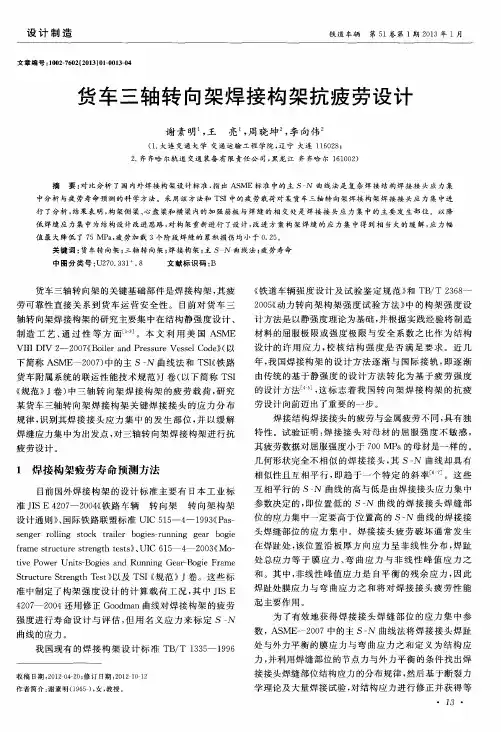
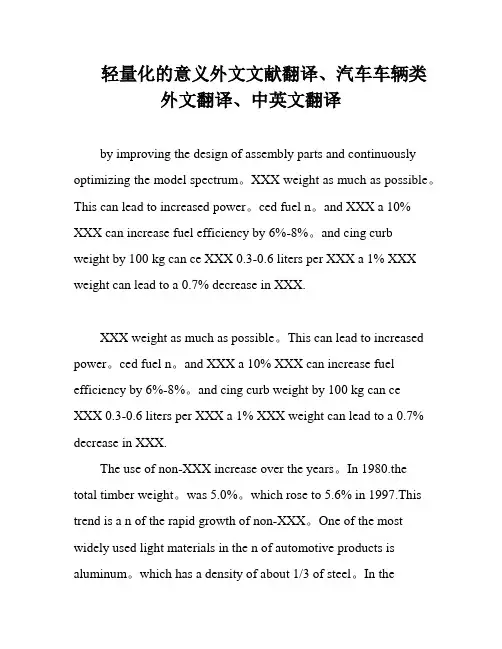
轻量化的意义外文文献翻译、汽车车辆类外文翻译、中英文翻译by improving the design of assembly parts and continuously optimizing the model spectrum。
XXX weight as much as possible。
This can lead to increased power。
ced fuel n。
and XXX a 10% XXX can increase fuel efficiency by 6%-8%。
and cing curb weight by 100 kg can ce XXX 0.3-0.6 liters per XXX a 1% XXX weight can lead to a 0.7% decrease in XXX.XXX weight as much as possible。
This can lead to increased power。
ced fuel n。
and XXX a 10% XXX can increase fuel efficiency by 6%-8%。
and cing curb weight by 100 kg can ceXXX 0.3-0.6 liters per XXX a 1% XXX weight can lead to a 0.7% decrease in XXX.The use of non-XXX increase over the years。
In 1980.the total timber weight。
was 5.0%。
which rose to 5.6% in 1997.This trend is a n of the rapid growth of non-XXX。
One of the most widely used light materials in the n of automotive products is aluminum。
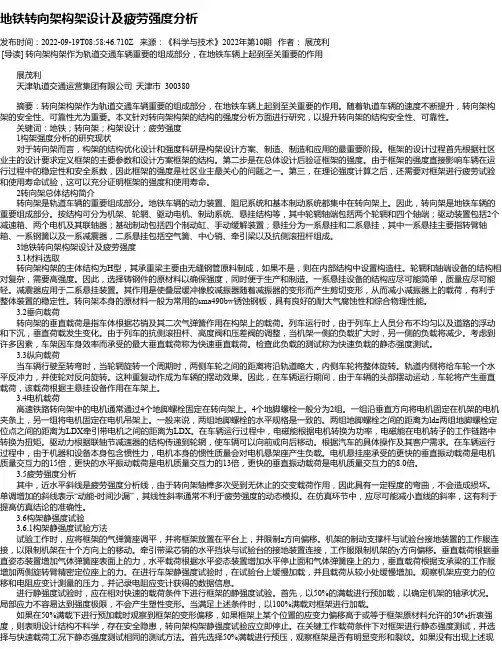
地铁转向架构架设计及疲劳强度分析发布时间:2022-09-19T08:58:46.710Z 来源:《科学与技术》2022年第10期作者:展茂利[导读] 转向架构架作为轨道交通车辆重要的组成部分,在地铁车辆上起到至关重要的作用展茂利天津轨道交通运营集团有限公司天津市 300380摘要:转向架构架作为轨道交通车辆重要的组成部分,在地铁车辆上起到至关重要的作用。
随着轨道车辆的速度不断提升,转向架构架的安全性、可靠性尤为重要。
本文针对转向架构架的结构的强度分析方面进行研究,以提升转向架的结构安全性、可靠性。
关键词:地铁;转向架;构架设计;疲劳强度1构架强度分析的研究现状对于转向架而言,构架的结构优化设计和强度科研是构架设计方案、制造、制造和应用的最重要阶段。
框架的设计过程首先根据社区业主的设计要求定义框架的主要参数和设计方案框架的结构。
第二步是在总体设计后验证框架的强度。
由于框架的强度直接影响车辆在运行过程中的稳定性和安全系数,因此框架的强度是社区业主最关心的问题之一。
第三,在理论强度计算之后,还需要对框架进行疲劳试验和使用寿命试验,这可以充分证明框架的强度和使用寿命。
2转向架总体结构简介转向架是轨道车辆的重要组成部分。
地铁车辆的动力装置、阻尼系统和基本制动系统都集中在转向架上。
因此,转向架是地铁车辆的重要组成部分。
按结构可分为机架、轮辋、驱动电机、制动系统、悬挂结构等,其中轮辋轴端包括两个轮辋和四个轴端;驱动装置包括2个减速箱、两个电机及其联轴器;基础制动包括四个制动缸、手动缓解装置;悬挂分为一系悬挂和二系悬挂,其中一系悬挂主要指转臂轴箱、一系钢簧以及一系减震器,二系悬挂包括空气簧、中心销、牵引梁以及抗侧滚扭杆组成。
3地铁转向架构架设计及疲劳强度3.1材料选取转向架构架的主体结构为H型,其承重梁主要由无缝钢管原料制成,如果不是,则在内部结构中设置构造柱。
轮辋和轴端设备的结构相对复杂,需要高强度。
因此,选择铸钢件的原材料以确保强度,同时便于生产和制造。
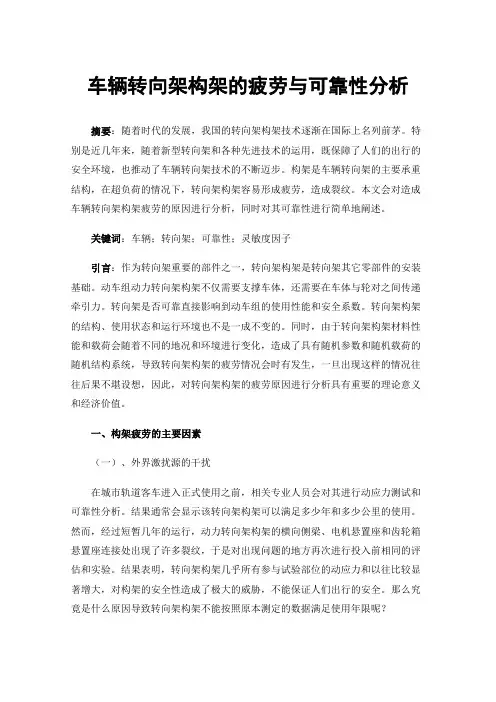
车辆转向架构架的疲劳与可靠性分析摘要:随着时代的发展,我国的转向架构架技术逐渐在国际上名列前茅。
特别是近几年来,随着新型转向架和各种先进技术的运用,既保障了人们的出行的安全环境,也推动了车辆转向架技术的不断迈步。
构架是车辆转向架的主要承重结构,在超负荷的情况下,转向架构架容易形成疲劳,造成裂纹。
本文会对造成车辆转向架构架疲劳的原因进行分析,同时对其可靠性进行简单地阐述。
关键词:车辆;转向架;可靠性;灵敏度因子引言:作为转向架重要的部件之一,转向架构架是转向架其它零部件的安装基础。
动车组动力转向架构架不仅需要支撑车体,还需要在车体与轮对之间传递牵引力。
转向架是否可靠直接影响到动车组的使用性能和安全系数。
转向架构架的结构、使用状态和运行环境也不是一成不变的。
同时,由于转向架构架材料性能和载荷会随着不同的地况和环境进行变化,造成了具有随机参数和随机载荷的随机结构系统,导致转向架构架的疲劳情况会时有发生,一旦出现这样的情况往往后果不堪设想,因此,对转向架构架的疲劳原因进行分析具有重要的理论意义和经济价值。
一、构架疲劳的主要因素(一)、外界激扰源的干扰在城市轨道客车进入正式使用之前,相关专业人员会对其进行动应力测试和可靠性分析。
结果通常会显示该转向架构架可以满足多少年和多少公里的使用。
然而,经过短暂几年的运行,动力转向架构架的横向侧梁、电机悬置座和齿轮箱悬置座连接处出现了许多裂纹,于是对出现问题的地方再次进行投入前相同的评估和实验。
结果表明,转向架构架几乎所有参与试验部位的动应力和以往比较显著增大,对构架的安全性造成了极大的威胁,不能保证人们出行的安全。
那么究竟是什么原因导致转向架构架不能按照原本测定的数据满足使用年限呢?经反复的实验表明,车轮表面的缺陷、轨道特殊区段的干扰、轨道的随机不平顺等原因是车辆振动的主要干扰源。
1、如车辆轮胎的平疤、径向跳动、擦伤和异常磨损等情况的发生都会增加轮轨的冲击力,不仅让列车正常运行时的安全性受到影响,而且也加剧了车辆的疲劳损伤,造成不可逆的伤害。
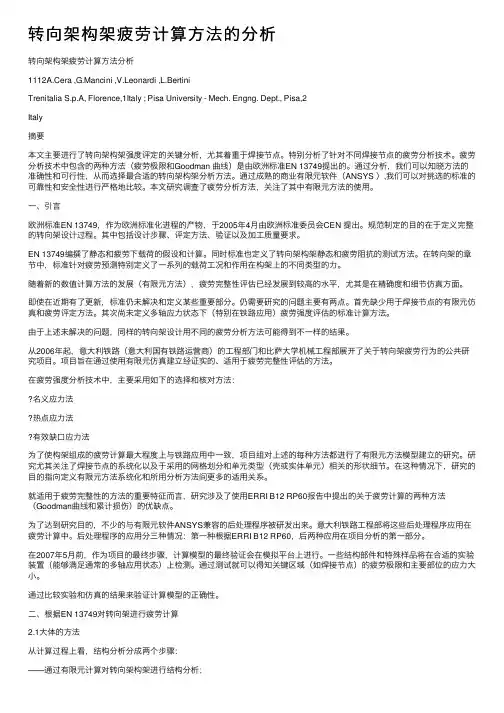
转向架构架疲劳计算⽅法的分析转向架构架疲劳计算⽅法分析1112A.Cera ,G.Mancini ,V.Leonardi ,L.BertiniTrenitalia S.p.A, Florence,1Italy ; Pisa University - Mech. Engng. Dept., Pisa,2Italy摘要本⽂主要进⾏了转向架构架强度评定的关键分析,尤其着重于焊接节点。
特别分析了针对不同焊接节点的疲劳分析技术。
疲劳分析技术中包含的两种⽅法(疲劳极限和Goodman 曲线)是由欧洲标准EN 13749提出的。
通过分析,我们可以知晓⽅法的准确性和可⾏性,从⽽选择最合适的转向架构架分析⽅法。
通过成熟的商业有限元软件(ANSYS ),我们可以对挑选的标准的可靠性和安全性进⾏严格地⽐较。
本⽂研究调查了疲劳分析⽅法,关注了其中有限元⽅法的使⽤。
⼀、引⾔欧洲标准EN 13749,作为欧洲标准化进程的产物,于2005年4⽉由欧洲标准委员会CEN 提出。
规范制定的⽬的在于定义完整的转向架设计过程。
其中包括设计步骤、评定⽅法、验证以及加⼯质量要求。
EN 13749编撰了静态和疲劳下载荷的假设和计算。
同时标准也定义了转向架构架静态和疲劳阻抗的测试⽅法。
在转向架的章节中,标准针对疲劳预测特别定义了⼀系列的载荷⼯况和作⽤在构架上的不同类型的⼒。
随着新的数值计算⽅法的发展(有限元⽅法),疲劳完整性评估已经发展到较⾼的⽔平,尤其是在精确度和细节仿真⽅⾯。
即使在近期有了更新,标准仍未解决和定义某些重要部分。
仍需要研究的问题主要有两点。
⾸先缺少⽤于焊接节点的有限元仿真和疲劳评定⽅法。
其次尚未定义多轴应⼒状态下(特别在铁路应⽤)疲劳强度评估的标准计算⽅法。
由于上述未解决的问题,同样的转向架设计⽤不同的疲劳分析⽅法可能得到不⼀样的结果。
从2006年起,意⼤利铁路(意⼤利国有铁路运营商)的⼯程部门和⽐萨⼤学机械⼯程部展开了关于转向架疲劳⾏为的公共研究项⽬。

09-第九章-转向架第九章转向架第一节概述转向架是保障机车安全运行的最关键部件之一,它对机车的安全性、舒适性、可靠运行及减少对轨道的动作用力、减轻对环境的污染等有着极为重要的作用。
它承受车体传来的各种静、动载荷,并传递牵引力、制动力,因此转向架必须有足够的强度,小的轮轨作用力,好的平稳性、稳定性和曲线通过性能,高的粘着利用率,可靠的牵引制动性能,并尽可能满足标准化,简统化的要求。
大秦线货运提速和重载货运交流传动电力机车转向架就是以满足上述要求为目标开展的。
“和谐2” 电力机车转向架是:基于法国标准的PRIMA货运机车转向架(22.5吨轴重)设计;按合同要求以满足轴重、轮径、车轮内侧距和环境等使用要求进行设计;“和谐2” 电力机车轴重要求是23t/25t, 转向架按25吨轴重设计。
转向架设计、制造采用的标准以EN、UIC和ISO等国际标准为主,同时也符合GB 146.1-83“机车车辆限界”对机车下部限界的要求。
转向架主要特性参数:转向架质量18690kg最高运行速度120km/h轴距2600 mm轮径(新轮)1250 mm电机采用抱轴式悬挂方式牵引电机功率1250kW齿轮箱底面距轨面高度≥120mm单个低位牵引杆踏面制动,每转向架有4个制动器,其中1个带停放制动其它结构特性:•设有轮缘润滑装置•设有撒砂和安全装置(1)(2)充分满足客户的使用要求,比如针对客户要求在零下40℃机车能够使用的条件和机车实际运营线路情况,提出原材料在零下40℃的低温冲击要求和轴承满足该线路机车振动条件的要求等;(3)设计过程是在既有成熟产品和技术标准基础上开展,引用的技术标准比较先进、全面。
HXD2机车转向架设计是在PRIMA原型车基础上进行适应改进设计,引用的技术标准主要以UIC和EN为主,主要部件都有标准可依,如车轮、车轴、弹簧、橡胶件、轴承、减振器和原材料等都有较详细的标准;产品设计以标准为基础但不局限于满足标准要求,针对客户特殊要求提出高于标准的要求。
汽车悬架原理外文文献及翻译(文档含中英文对照即英文原文和中文翻译)The rinciple Of Car SuspensionsBy William HarrisUniversity of MichiganWhen people think of automobile performance, they normally think of horsepower, torque and zero-to-60 acceleration. But all of the power generated by a piston engine is useless if the driver can't control the car. That's why automobile engineers turned their attention to the suspension system almost as soon as they had mastered the four-stroke internal combustion engine.The job of a car suspension is to maximize the friction between the tires and the road surface, to provide steering stability with good handling and to ensure the comfort of the passengers. In this article, we'll explore how car suspensions work, how they've evolved over the years and where the design of suspensions is headed in the future.1.Vehicle DynamicsIf a road were perfectly flat, with no irregularities, suspensions wouldn't be necessary. But roads are far from flat. Even freshly paved highways have subtle imperfections that can interact with the wheels of a car. It's these imperfections that apply forces to the wheels. According to Newton's laws of motion, all forces have both magnitude and direction. A bump in the road causes the wheel to move up and down perpendicular to the road surface. The magnitude, of course, depends on whether the wheel is striking a giant bump or a tiny speck. Either way, the car wheel experiences a vertical acceleration as it passes over an imperfection.Without an intervening structure, all of wheel's vertical energy is transferred to the frame, which moves in the same direction. In such a situation, the wheels can lose contact with the road completely. Then, under the downward force of gravity, the wheels can slam back into the road surface. What you need is a system that will absorb the energy of the vertically accelerated wheel, allowing the frame and body to ride undisturbed while the wheels follow bumps in the road.The study of the forces at work on a moving car is called vehicle dynamics, and you need to understand some of these concepts in order to appreciate why a suspension is necessary in the first place. Most automobile engineers consider the dynamics of a moving car from two perspectives:1)Ride - a car's ability to smooth out a bumpy road2)Handling - a car's ability to safely accelerate, brake and cornerThese two characteristics can be further described in three important principles - road isolation, road holding and cornering. The table below describes these principles and how engineers attempt to solve the challenges unique to each.A car's suspension, with its various components, provides all of the solutions described.2.The Chassis SystemThe suspension of a car is actually part of the chassis, which comprises all of the important systems located beneath the car's body.These systems include:1)T he frame - structural, load-carrying component that supports the car's engine and body, which are in turn supported by the suspension2)T he suspension system - setup that supports weight, absorbs and dampens shock and helps maintain tire contact3)T he steering system - mechanism that enables the driver to guide and direct the vehicle4)T he tires and wheels - components that make vehicle motion possible by way of grip and/or friction with the roadSo the suspension is just one of the major systems in any vehicle.With this big-picture overview in mind, it's time to look at the three fundamental components of any suspension: springs, dampers and anti-sway bars.figure 2-1 Chassis3.SpringsToday's springing systems are based on one of four basic designs:1)Coil springs - This is the most common type of spring and is, in essence, a heavy-duty torsion bar coiled around an axis. Coil springs compress and expand to absorb the motion of the wheels.2)Leaf springs - This type of spring consists of several layers of metal (called "leaves") bound together to act as a single unit. Leaf springs were first used on horse-drawn carriages and were found on most American automobiles until 1985. They are still used today on most trucks and heavy-duty vehicles.3)Torsion bars - Torsion bars use the twisting properties of a steel bar to provide coil-spring-like performance. This is how they work: One end of a bar is anchored to the vehicle frame. The other end is attached to a wishbone, which acts like a lever that moves perpendicular to the torsion bar. When the wheel hits a bump, vertical motion is transferred to the wishbone and then, through the levering action, to the torsion bar. The torsion bar then twists along its axis to provide the spring force. European carmakers used this system extensively, as did Packard and Chrysler in the United States, through the 1950s and 1960s. 4)Air springs - Air springs, which consist of a cylindrical chamber of air positioned between the wheel and the car's body, use the compressive qualities of air to absorb wheel vibrations. The concept is actually more than a century old and could be found on horse-drawn buggies. Air springs from this era were made from air-filled, leather diaphragms, much like a bellows; they were replaced with molded-rubber air springs in the 1930s.Based on where springs are located on a car -- i.e., between the wheels and the frame -- engineers often find it convenient to talk about the sprung mass and the unsprung mass.4.Sprung and Unsprung MassThe sprung mass is the mass of the vehicle supported on the springs, while the unsprung mass is loosely defined as the mass between the road and the suspension springs. The stiffness of the springs affects how the sprung mass responds while the car is being driven. Loosely sprung cars, such as luxury cars (think Lincoln Town Car), can swallow bumps and provide a super-smooth ride; however, such a car is prone to dive and squat during braking and acceleration and tends to experience body sway or roll during cornering. Tightly sprung cars, such as sports cars (think Mazda Miata), are less forgiving on bumpy roads, but they minimize body motion well, which means they can be driven aggressively, even around corners.So, while springs by themselves seem like simple devices, designing and implementing them on a car to balance passenger comfort with handling is a complex task. And to make matters more complex, springs alone can't provide a perfectly smooth ride. Why? Because springs are great at absorbing energy, but not so good at dissipating it. Other structures, known as dampers, are required to do this.5.Shock AbsorbersUnless a dampening structure is present, a car spring will extend and release the energy it absorbs from a bump at an uncontrolled rate. The spring will continue to bounce at its natural frequency until all of the energy originally put into it is used up. A suspension built on springs alone would make for an extremely bouncy ride and, depending on the terrain, an uncontrollable car.Enter the shock absorber, or snubber, a device that controls unwanted spring motion through a process known as dampening. Shock absorbers slow down and reduce the magnitude of vibratory motions by turning the kinetic energy of suspension movement into heat energy that can be dissipated through hydraulic fluid. To understand how this works, it's best to look inside a shock absorber to see its structure and function.A shock absorber is basically an oil pump placed between the frame of the car and the wheels. The upper mount of the shock connects to the frame (i.e., the sprung weight), while the lower mount connects to the axle, near the wheel (i.e., the unsprung weight). In a twin-tube design, one of the most common types of shock absorbers, the upper mount is connected to a piston rod, which in turn is connected to a piston, which in turn sits in a tube filled with hydraulic fluid. The inner tube is known as the pressure tube, and the outer tube is known as the reserve tube. The reserve tube stores excess hydraulic fluid.When the car wheel encounters a bump in the road and causes the spring to coil and uncoil, the energy of the spring is transferred to the shock absorber through the upper mount, down through the piston rod and into the piston. Orifices perforate the piston and allow fluid to leak through as the piston moves up and down in the pressure tube. Because the orifices are relatively tiny, only a small amount of fluid, under great pressure, passes through. This slows down the piston, which in turn slows down the spring.Shock absorbers work in two cycles -- the compression cycle and the extension cycle. The compression cycle occurs as the piston moves downward, compressing the hydraulic fluid in the chamber below the piston. The extension cycle occurs as the piston moves toward the top of the pressure tube, compressing the fluid in the chamber above the piston. A typical car or light truck will have more resistance during its extension cycle than its compression cycle. With that in mind, the compression cycle controls the motion of the vehicle's unsprung weight, while extension controls the heavier, sprung weight.All modern shock absorbers are velocity-sensitive -- the faster the suspension moves, the more resistance the shock absorber provides. This enables shocks to adjust to road conditions and to control all of the unwanted motions that can occur in a moving vehicle, including bounce, sway, brake dive and acceleration squat.6.Struts and Anti-sway Barsfigure 6-1 Common strut designAnother common dampening structure is the strut -- basically a shock absorber mounted inside a coil spring. Struts perform two jobs: They provide a dampening function like shock absorbers, and they provide structural support for the vehicle suspension. That means struts deliver a bit more than shock absorbers, which don't support vehicle weight -- they only control the speed at which weight is transferred in a car, not the weight itself.Because shocks and struts have so much to do with the handling of a car, they can be considered critical safety features. Worn shocks and struts can allow excessive vehicle-weight transfer from side to side and front to back. This reduces the tire's ability to grip the road, as well as handling and braking performance.7.Anti-sway BarsAnti-sway bars (also known as anti-roll bars) are used along with shock absorbers or struts to give a moving automobile additional stability. An anti-sway bar is a metal rod that spans the entire axle and effectively joins each side of the suspension together.When the suspension at one wheel moves up and down, the anti-sway bar transfers movement to the other wheel. This creates a more level ride and reduces vehicle sway. Inparticular, it combats the roll of a car on its suspension as it corners. For this reason, almost all cars today are fitted with anti-sway bars as standard equipment, although if they're not, kits make it easy to install the bars at any time.8.The Future of Car SuspensionsWhile there have been enhancements and improvements to both springs and shock absorbers, the basic design of car suspensions has not undergone a significant evolution over the years. But all of that's about to change with the introduction of a brand-new suspension design conceived by Bose -- the same Bose known for its innovations in acoustic technologies. Some experts are going so far as to say that the Bose suspension is the biggest advance in automobile suspensions since the introduction of an all-independent design.How does it work? The Bose system uses a linear electromagnetic motor (LEM) at each wheel in lieu of a conventional shock-and-spring setup. Amplifiers provide electricity to the motors in such a way that their power is regenerated with each compression of the system. The main benefit of the motors is that they are not limited by the inertia inherent in conventional fluid-based dampers. As a result, an LEM can extend and compress at a much greater speed, virtually eliminating all vibrations in the passenger cabin. The wheel's motion can be so finely controlled that the body of the car remains level regardless of what's happening at the wheel. The LEM can also counteract the body motion of the car while accelerating, braking and cornering, giving the driver a greater sense of control.Unfortunately, this paradigm-shifting suspension won't be available until 2009, when it will be offered on one or more high-end luxury cars. Until then, drivers will have to rely on the tried-and-true suspension methods that have smoothed out bumpy rides for centuries.汽车悬架的原理当人们考虑汽车性能的时候,他们通常认为是马力,扭矩和零到60的加速时间。
汽车起重机臂架机构设计与仿真外文文献翻译Automobile crane is mounted on a common automobile chassis or special automobile chassis on a crane, the driving cab and a lifting control room separated set. The crane has the advantages of good mobility, transfer quickly. Drawback is that work must support legs, cannot load driving, also do not fit in the soft or muddy ground work. Truck crane chassis performance equivalent to the same vehicle gross weight of truck, meet the technical requirements of road vehicles, and thus can be in various kinds of highway pass unimpeded. This kind of crane general with on off, two control room, operation must lend a supporting leg stability. Lifting weight range greatly, from 8tons to 1000 tons, chassis number of axles, from 2to 10. Is the largest, the most widely used crane type1.Development processChinese automobile crane was born in the 10's of last century, after nearly 30 years of development, have3major technical improvements, respectively, for70 years the introduction of the technology, and 80 years the introduction of Japanese technology, and 90 years the introduction of German technology. But overall, China 's automobile crane industry always walk the road of independent innovation, has its own clear sequence of development, especially in recent years, China 's automobile crane industry obtained great progress, while compared with foreign countries there is still a certain gap, but the gap is gradually narrowing. But China is currently in the medium and small tonnage truck crane performance has been good, can meet the practical requirement of production. In the near future, China 's automobile crane industry will become a steady development, commercialize degree tall mature industry. Many experts think, the rapid development of the market, is China's auto crane industry each manufacturer favorable technical innovation foundation and environment. In recent years, Chinese automobile crane industry except for a small company and Japanese crane brand manufacturers joint venture outside, other manufacturers have been chasing the foreign advanced level in the process, always adhere to independent technical innovation road, basically there is no overall introduction of foreign technology practice, also make the Chinese automobile craneindustry in reaching and close to the international advanced level, the product technology has obvious Chinese characteristics. Chinese automobile crane has a large number of the use of PLC programmable integrated control technology, with a bus interface of the hydraulic valve block, a hydraulic motor, pump control and executive components has been more mature, hydraulic and electrical appliances has achieved a close combination. Can be achieved by software control performance by adjusting, greatly simplifies the control system, reduce the hydraulic components, to improve the stability of the system, with the realization of automatic fault diagnosis, remote control capability. The current China's new generation of automobile crane, lifting operation mode of operation, large area application pilot proportional control, has good adjustment performance and fine control performance, small operation force, is not easy to fatigue. Through the pilot scale handle to realize the proportion of conveying a variety of load of the stepless speed regulation, effectively prevent the hoisting operation of the two sliding phenomenon, greatly improve the lifting of the job security, the reliability and working efficiency. Part of the large car type crane 's telescopic arm on the use of single cylinder bolt expansion technology, through the hydraulic pin function, with a single cylinder can complete multiple arm movement, and to various working level control and automatic telescopic, changed the past to cylinder and the Department of wire ropes work way, make the crane relatively lighter, to expand the crane to the higher working height development space. In the international market in the process, Chinese automobile crane industry in recent years quality level rise quickly, also received international support and highly positive, due to product specifications, user's professional quality is higher, the quality of export products feedback than in the past was reduced significantly, reflecting good product. This is Chinese automobile crane industry development has laid a good foundation2.Automobile crane product characteristics1luxury full cab and the control room with modern streamlined style;2big power, small oil consumption, noise in line with national standards;3walking platform for all covered, the job on the car and maintenance;4 leg system adopts the double control, convenient and practical; the 6product of the performance indicators reached50 tons TADANO product performance indicators3.Working principleIn the lifting arm inside the following a rotation of the drum, it around the steelwire rope, wire rope through in the next section on top of the arm on the pulley, the upper section jib pull away, and so on. When retracted, the reel reverse recovery of wire rope, lifting arm by gravity back shrinkage. The rotation of the drum is driven by a hydraulic motor, so they can see the two tubing, but never as cylinder. In addition there are a number of truck crane telescopic boom is installed inside the plunger type oil cylinder is set, but the application of rare. Because the multistage plunger type oil cylinder is expensive, and the lifting arm loading will happen when the elastic bending, to adversely affect the service life of cylinder4.The type of truck craneAutomobile crane of many kinds, its classification method also each are not identical, are: according to the weight classification: light truck crane ( from the weight of 5 tons ), automobile crane ( from the weight of5-15 tons), heavy duty truck crane ( from the weight of5-50 tons), super heavy-duty truck crane (starting weight in more than 50 tons ). In recent years, due to the use of requirements, of which the weight tends to be improved, as has been to produce50-100tons large truck crane. According to leg type: the breaststroke leg, X type, H type support leg leg. The breaststroke leg span is0? Only apply to small tonnage crane; X type support leg is easy to slip, are rarely used; H type support leg can realize the larger span, the stability has obvious superiority, so China's current production of hydraulic truck crane using H type support leg. According to the transmission mode: mechanical transmission, electrical transmission, hydraulic transmission three. According to the lifting device in the horizontal plane can be rotary range (i.e., turntable rotation range ): rotary crane ( turntable can be arbitrarily rotated360 °) and non full revolving crane ( turntable rotating angle less than 270 °). According to the jib structure form: folding type crane, telescopic boom and jib crane truss.5.The basic structure of automobile craneAutomobile crane mainly consists of lifting, luffing, rotary, lifting arm and the vehicle chassis. Because the hydraulic technology, the electronics industry, high strength steel and the development of the automobile industry, promote the development of automobile crane. Since the major work, the long time of preparation and mechanical drive type truck crane has been replaced by hydraulic truck crane. Hydraulic truck crane hydraulic system adopts the hydraulic pump, quantitative or variable motor in crane, luffing jib rotary, telescopic and leg extension and can be used alone or in combination. Used motor overheat protection, and toprevent the wrong operation safety device. Large tonnage hydraulic truck crane with multiple gear pump, can also realize the confluence of the motion acceleration. In the hydraulic system with automatic overload safety valve, buffering valve and hydraulic lock, to prevent the crane operation, overload or stall and tubing suddenly rupture caused by the accident. Truck crane with range indicators and height limiter, prevent overload or super length, drum and pulley is provided with a wire rope switch device. For the 16t requirements set below the crane lifting display,16t and over 16t crane torque limiter setting, and the alarm device. Hydraulic truck crane lifting arm composed of a plurality of arm segments, can according to the different requirements of the design of lifting height. Boom telescoping is a sequential extension, the other is a synchronous telescoping. Large tonnage crane in order to increase the lifting capacity of most of the use of synchronous telescoping. Each arm section of the telescopic by hydraulic control, retractable. With a jib crane, in running condition, the auxiliary arm arranged on the arm of the Lord general lateral or below. Turntable is mainly used to decorate the hoisting mechanism, slewing mechanism, jib derricking cylinder and lower fulcrum and manipulation device. For, in large tonnage cranes, some are still housed engine turntable. Turntable and between the underframe can use under vertical load, horizontal load and capsize moment slewing bearing connection. In order to prevent the occurrence of slip when driving the turntable, the turntable locking device is arranged. The rotary mechanism is composed of quantitative motor drive. Slewing mechanism of the output gear and the slewing gear. Realize the crane turntable along the rotary center for360degree rotation. Jib luffing, by single or double hydraulic cylinder through an oil control. The lifting mechanism is composed of oil control variables or quantitative motor through reducer driven reel. Due to the adoption of the hydraulic torque converter, crane's motion can be infinitely variable speed, can make the load by power control drop inching speed. In order to prevent roll, a steel wire rope three ring protection device and alarm device. In big tonnage truck crane, according to the needs of the market allocation of auxiliary lifting mechanism, for double operation.6.Safety locking and speed restriction analysisIn 1, after the brake locking automobile crane valve of the valve core and the valve body between the clearance seal, under its own gravity and lifting load gravity dual role, brake pressure oil often through the valve spool and valve body slight gap between the slow leakage, not on the hydraulic cylinder or a hydraulic motor torealize effective to lock, and therefore prone to crane, jib, drop retraction rate increase, leg sinking accident, ranging from the crane can not work normally, resulted in heavy vehicles overturning, casualty accident. Eliminate hidden safety measures at least one of the following4. (1) in the return circuit of series hydraulic lock check valve reverse circuit only when the control circuit input pressure oil can be connected. It is a kind of circuit to realize on-off control switch element, usually also known as hydraulic lock. The hydraulic lock reverse connected in series in a hydraulic cylinder ( hydraulic motor ) of the return circuit, and the control circuit and the hydraulic cylinder ( hydraulic motor ) into the oil line, can make the return circuit in braking state control circuit without the pressure of oil and cut off, the hydraulic cylinder ( hydraulic motor ) due to locking action. Hydraulic lock locking effect depends on the valve core and the valve shape structure. If the ball valve type valve core or slide valve, the leak will still is hard to avoid, namely oil liquid is possible through the impact due to valve core groove or the valve core and the valve body between the clearance leakage. Therefore, used in automobile crane hydraulic lock valve should choose good sealing performance of the cone core, even if the long-term use can also ensure that the drop of oil leakage. According to the working characteristics of automobile crane, should be chosen with unloading valve of type IY-F hydraulic lock. On the supporting leg oil, a support locking and suspension lock two lock request. According to different circuit, each leg can be used only as a liquid control one-way valve, can only play a one-way locking action of hydraulic lock, or by the two liquid control one-way valve cross connected by a bidirectional hydraulic lock. The general is used after a scheme. Each support leg locking device must be set up independently.(2) in the return circuit of series balance valve balance valve is essentially one-way valve and control discharge type sequence valve and valve combination, which in the automobile crane installation position and the locking principle and the hydraulic lock of exactly the same, that is installed in the return circuit, brake after severing the return circuit. If the circuit has no other special requirements, or should try to adopt the price relatively low hydraulic lock. (3) improve the hydraulic components of the seal in the circuit in the installation of hydraulic lock or balance valve, does not necessarily completely guarantee mechanism brake to lock, hydraulic cylinder ( hydraulic motor ) seal is the key factor to restrict the lock system. Hydraulic components of the oil leakage and leakage inside the two. Hydraulic cylinder inner leakage is not easy to detect, will cause the outrigger retractable, and telescopiccrane luffing mechanism to lock3and sunk. Therefore, to improve the hydraulic cylinder sealing effect, the key is to solve occurred in its internal problem of internal leakage. In general, the hydraulic cylinder inner leakage volume should be strictly restricted. When the security check, the specified pressure piston moving distance for10min should not be greater than0.5min. More than this value, that the sealing performance is not good, to timely replacement of the Y ring. (4) crane lifting hydraulic motor external brake to make the hydraulic cylinder, hydraulic motor long no leaks are very difficult to observe this, the sealing piece after wear and tear leakage will be imperceptibly produce. Thus, if the firm locking only mounted brake one method, and only in the crane lifting hydraulic motor with, other such as telescopic crane, luffing and will not use. On the hoisting elevator mechanism plays the role of brake is actually a small single pole single action hydraulic cylinder, brake is normally closed, the braking force depends on the cylinder spring force. In order to obtain the ideal locking effect, of course, hope that the spring force of the bigger the better, but too much of the force of the spring and the brake release energy consumption increase, so the external brake is the locking scheme by means of auxiliary. 2, movement speed because the automobile crane lifting, telescopic crane, jib luffing are longer, body or the load in the process of descending through the effect of gravity and acceleration phenomenon is also a prominent problem. Automobile crane speed usually use the following two methods. (1) in the return circuit of series balance valve valve not only can lock, but also the speed limit. When institutions or the decrease of load balance valve, sequence valve with valve core role of balance, so that the hydraulic cylinder ( hydraulic motor ) the return oil flow to maintain steady state, thereby allowing the hydraulic cylinder ( hydraulic motor ) to maintain uniform velocity motion. In order to obtain a uniform rate of decline, system design should pay attention to two points: one is unable to save cost, simply using a general check valve and external control internal leakage type sequence valve and connecting to replace the balance valve. This is because the balance valve are one-way valve and the external control internal leakage type sequence valve combinations, but the sequence valve has increased the double-layer spring, damping hole, so that the valve damping device; the two is the balance valve control circuit to tandem throttle valve, so that the sequence valve spool movement" hysteresis", not because of external pressure the tiny change of the speed of change. In a plan, use the balance valve effect is ideal, is the preferred method. (2) using themanual reversing valve speed in all of the reversing valve, only manual reversing valve in the direction at the same time, through the control of valve opening size can be both speed and the throttle effect. Therefore, when the automobile crane or load downward acceleration, can be reduced by the manual reversing valve handle pull level to reduce the valve opening of the solution to it. Of course, because the driver's hand jitter will make the manual reversing valve to limit the effect is very not ideal, but because the automobile crane loading and unloading speed often according to the construction site specific conditions constantly adjusted, body movement is often not continuous intermittent operation, so the skilled driver manual reversing valve is able to receive the limit effect. In short, the automobile crane lifting, telescopic crane, jib luffing mechanism not only has3locking and speed requirements, should be used to meet the locking and speed restriction of two requirements for balancing valve, coupled to a mechanical brake.7.Safety operationCrane ahead prohibited operations, namely the hook gravity during hoisting operation shall not exceed the gyration center and the front leg (left and right ) ground center line connection. In weight indicating device failure cannot be used in case, according to the lifting performance table shall be determined by the weight of the crane operation, must normative behavior, ensure safe and correct. Lifting heavy objects do not drop arm; must drop arm should be heavy down again operation; drop arm when the throttle is small, the lifting arm when the throttle to rotary motion; smoothly, not suddenly stop; before operation to check carefully, to prohibit the use of unqualified wire rope and a lifting chain; lifting weights do not drop arm; must drop arm should be heavy down again operation; drop arm when the throttle to small.汽车起重机是装在普通汽车底盘或特制汽车底盘上的一种起重机,其行驶驾驶室与起重操纵室分开设置。
铁道车辆转向架构架疲劳强度研究铁道车辆转向架构疲劳强度研究1. 引言铁道车辆作为重要的交通工具,其安全性和可靠性备受关注。
转向架作为车辆的关键部件之一,其疲劳强度对车辆的运行安全具有重要影响。
因此,对铁道车辆转向架构造进行疲劳强度研究具有重要意义。
2. 转向架构造及其作用转向架是铁道车辆的重要组成部分,主要由车轮、轮轴、轮对、承载架等构成。
其作用是支撑车辆重量、传递牵引和制动力,同时保证车辆的稳定性和操纵性。
3. 疲劳强度的概念及影响因素疲劳强度是指材料在循环载荷下发生疲劳破坏的能力。
铁道车辆转向架的疲劳强度受到多种因素的影响,包括材料的强度、载荷的大小和循环次数等。
4. 疲劳强度的评估方法为了评估转向架的疲劳强度,可以采用有限元分析、应力集中因子法和疲劳试验等方法。
有限元分析可以通过建立转向架的数值模型,计算其应力和应变分布,进而预测疲劳寿命。
应力集中因子法则通过提取关键部位的应力集中因子,进行疲劳寿命预测。
疲劳试验则通过对转向架进行实际加载,观察其疲劳破坏形态,评估疲劳强度。
5. 疲劳强度优化设计为了提高转向架的疲劳强度,可以采取优化设计的方法。
例如,可以通过增加材料的强度、改变结构的几何形状、优化焊接工艺等手段,来提高转向架的疲劳寿命。
6. 疲劳强度监测与维护为了保证转向架的安全运行,需要进行定期的疲劳强度监测和维护。
可以采用无损检测技术,如超声波检测、磁粉检测等,对转向架进行检测,及时发现潜在的缺陷和疲劳损伤,并进行修复或更换。
7. 结论铁道车辆转向架的疲劳强度研究对保障车辆的运行安全具有重要意义。
在研究过程中,需要综合考虑材料、结构和加载等因素,并采用合适的评估方法和优化设计手段,以提高转向架的疲劳寿命。
同时,定期进行疲劳强度监测和维护,可有效延长转向架的使用寿命,确保铁道车辆的安全运行。
通过进一步的研究和应用,有望提高铁道车辆转向架的疲劳强度,为乘客提供更安全、舒适的出行体验。
1 Bogie frame design in consideration of fatigue strength and weight reduction B H Parkand K Y Lee
School of Mechanical Engineering,Yonsei University,Seoul,Republic of Korea The manuscript was received on 8 April 2005 and was accepted after revision for publication on 25 November 2005. DOI: 10.1243/09544097F01405
Abstract: In the development of a bogie, the fatigue strength of a bogie frame is an important design criterion. In addition, weight reduction is required in order to save energy and material .In this study, the fatigue analysis of a bogie frame by using the finite-element method is performed for various loading conditions according to the UIC standards and it is attempted to minimize the weight of the bogie frame by artificial neural network and genetic algorithm. Keywords: bogie, strength, fatigue analysis, neural network, optimization. 1 INTRODUCTION
A bogie in a train is a very important structural component loaded by various forces in the rail way vehicle motion. The motion of a railway vehicle is affect by the geometry of the track, the interaction between wheels and rails, the suspension, and the inertias of component part s. In the meantime, the weight of a bogie structure should be as light as possible at higher running speed. Therefore, the strength of the bogie should be carefully calculated and analysed by the international standards such as UIC [1] and JIS [2], in order to obtain a reasonable design scheme. In the past design process, the steps of many experiments, field tests, and prototypes to improve and obtain a reasonable design required much time and high costs. In the computer-aided engineering (CAE) product design step, however,the practical use of finite- element (FE) analysis can reduce the costs and time. The FE analysis of the bogie frame was studied several times [3,4]. In addition, the bogie has a large proportion of the total weight of a vehicle. Savings of energy and material are currently design drivers towards lightweight vehicle constructions. In 2
CAE product design step, optimization for weight reduction and application of the optimal algorithm can make the light weight and the constraint conditions for the fatigue strength satisfy. It is a typical structural optimization problem to minimize the weight of the bogie under the fatigue constraint, but the problem cannot be solved by simply applying the existing numerical optimization algorithms. In the problem, the fatigue constraint is not expressed as an analytical function in terms of the design variables.
In this article, the FE model of the bogie frame is constructed to simulate the fatigue test. The bogie that is used in this study is composed of welded frame, bolster, self-steering mechanism, primary suspension, secondary suspension, and disc brake system. The fatigue strength of the bogie frame is estimated by the international standard UIC615-4 ‘Motive Power Units Bogies and Running Gear Bogie Frame Structure Strength Test’. The 3
optimization problem is composed of an object function for the weight reduction of the bogie and the constraint conditions for the fatigue design criteria. The artificial neural network (ANN) to approximate a function for the fatigue constraint and the micro genetic algorithm (MGA) are used to solve this optimization problem. 2 STRESS ANALYSIS OF THE BOGIE FRAME 2.1 FE model of the bogie frame In this study, the analysed bogie frame is a bolster type bogie (Fig. 1(a)). The numerical analysis by the FE method is performed to evaluate the fatigue strength of the bogie frame except the bolster. The bogie is modelled using shell and solid elements and the FE model is shown in Fig.1(b ).The trailer bogie frame is meshed to have 28, 251 nodes, 23,870 rectangular shell elements, and 2710 hexagonal solid elements. Considering the boundary conditions of the trailer bogie frame for the primary suspension, the spring boundary elements are established and the stiffness of the elements is the same as the primary suspension. There are 12 spring elements for the primary suspension in the trailer bogie frame. The software programs used are Altair Hyper Mesh and ABAQUS . The material used in the bogie frame is SWS490A defined in reference [ 2 ] and the material properties are shown in Table 1.
2.2 Load conditions and the evaluation of fatigue strength of the bogie frame The fatigue analysis is based on the UIC standard. The main in- service load case is designed to verify the absence of any risk of fatigue cracks occurring under the combined